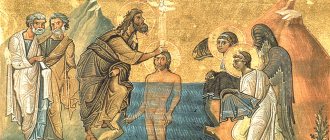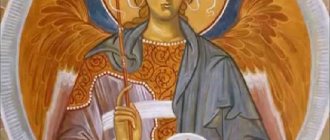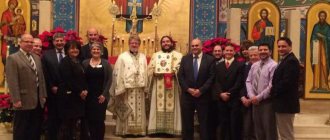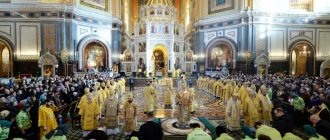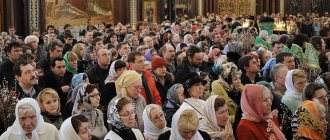Each rank has its own address
Each rank has its own address, accepted in church protocol. To understand which one to choose, you need to determine who is in front of you: a deacon or an archimandrite. In the Orthodox Church there are three degrees of clergy:
- Deacon (archdeacon, protodeacon, deacon, hierodeacon);
- Priestly (protopresbyter, archpriest, archimandrite, abbot, priest, hieromonk);
- Episcopal (patriarch, metropolitan, archbishop, bishop).
And two categories of clergy: black (monastic) and white. The white clergy is the most numerous: it includes clergy who did not take monastic vows.
They are allowed to have a family and children, they are closest to worldly life. The monastic clergy assumes complete celibacy; they devote their lives to serving God and take three monastic vows - chastity, obedience and non-covetousness (voluntary poverty).
The deacon does not wear a pectoral cross and is addressed as “Father Deacon”
| Secular clergy | Religious clergy | Application form |
| Deacon, Archdeacon, Protodeacon | Hierodeacon | to the archi-, protodeacon: father archi-, protodeacon (name)..., to the deacon, hierodeacon: father (name)... |
| Priest | Hieromonk | Your Reverence, Father (name)... |
| Protopresbyter, archpriest | Hegumen, archimandrite | Your Reverence, Father (name) |
| Abbess | Venerable Mother (name) | |
| Bishop | Your Eminence, Most Reverend Bishop (name) | |
| Archbishop, Metropolitan | Your Eminence, Your Eminence Vladyka (name), (Your Beatitude, Your Eminence Vladyka (name) | |
| Patriarch | Your Holiness (name), Most Holy Bishop (name) | |
| Monk, novice | honest brother (father) (name) | |
| Nun, novice | sister (name) |
Taken together, the three degrees, making up the three-rank hierarchy of the Orthodox Church, form the clergy. Therefore they are called clerics, or otherwise clergy. In addition to the clergy, there are also clergy - subdeacons, readers (singers), and candlebearers.
They are lower clerics and assist the clergy in performing divine services. As a rule, parishioners do not turn to them.
In addition, clergy, priests and higher officials of the Church have strict divisions in their responsibilities:
- Deacons proclaim prayer requests during services and help the priest during the Sacraments;
- Priests (priests, archpriests) can perform the Sacraments;
- Bishops not only perform the Sacraments, but can also ordain deacons and priests.
The difference between a deacon and a priest is the presence of a pectoral cross
The priest must wear a pectoral cross and you can address him as “father.” It is
quite simple to distinguish a deacon from a priest: the deacon does not have a pectoral cross. The archimandrite wears a cross with decorations, the archpriest (abbot) wears a gilded or decorated cross, the priest (hieromonk) wears a silver cross.
In order not to be mistaken, you can use the simplest address: Father (name), and if you know the position, then (rector, vicar, dean): Father rector, father deacon, etc.
Sometimes getting a hint on the question of how to greet a priest (a person of clergy) will help you get acquainted. The clergy themselves, when introducing themselves, state their rank and name: Archpriest Vasily, Archdeacon Nikolai, and so on.
It is not customary for clergy to say “Hello” or “Good afternoon” when meeting
One of the important points is the form of greeting that the laity allows towards the priest in the church. Often people who come to the temple turn to the clergy: “Hello, good afternoon!” This is incorrect, because. According to church etiquette, after the words of greeting, you need to take a blessing, saying “bless...”.
You can say: “Good afternoon, father, bless!” or “Forgive me, bless me…” or even shorter: “Bless me, father (name).” It wouldn’t be a sin if you added the time of day or a holiday greeting, for example: “Good morning, father, bless!” or “Christ is risen, father (name),” bless!” You can ask a priest for a blessing even outside the church and if he is dressed in secular clothes.
When you meet a priest, bend down a little, fold your right hand over your left, palms up, and say: “Father, bless.”
Patriarch Kirill should be addressed as “Your Holiness” or “His Holiness Vladyka Kirill.”
Another common appeal among us, “mother,” is permissible only in relation to the abbess of the monastery, but not to a nun. It is also customary to address the wives of priests and deacons as “Mother (name).”
Preface
Dear reader, first of all, in order to know how to address a clergyman correctly, you need to know their external differences.
We can say that it’s like military shoulder straps, which you just looked at and understood everything, found the words to address (Although, of course, someone in military uniform does not understand anything). Before you start reading this article, I recommend that you familiarize yourself with the previous material, “About Servants in the Temple,” which talks in detail about clergy and clergy.
The rules for oral communications also apply to written ones.
These rules must also be followed in written requests. Official letters are written on a special form, informal letters are written on plain paper or on a letterhead with the name and position of the sender printed in the upper left corner (the reverse side of the sheet is usually not used). It is not customary for the Patriarch to send a letter on letterhead.
When writing to the hierarchs of the Local Orthodox Churches, the title of the Primate of the Church (Patriarch, Metropolitan or Archbishop) is always written with a capital letter. The title of the First Hierarch of the Autonomous Church is written in the same way. If the First Hierarch bears the double (triple) title of Patriarch and Metropolitan (Archbishop), then all these titles are also written with a capital letter: His Beatitude Philaret; Archbishop of Minsk.
Clergy of lower ranks are addressed briefly: His Most Reverend Archpriest (or Priest) (name, surname, position); in this case, the surname of the monastic person, if indicated, is always given in parentheses.
In accordance with accepted rules, a letter consists of: indication of the addressee, address (address-title), text itself, compliment, signature and date. In an official letter, the addressee includes the person's full title and position, in the dative case, for example, “To His Eminence, Most Reverend (name), Archbishop (name of the department), Chairman (name of the Synodal Department, commission, etc.).”
An address or address-title is an honorary title of the addressee. They start a letter with it and use it in the text. “Your Holiness” (in a letter to the Patriarch), “Your Majesty” (in a letter to the monarch), “Your Excellency,” etc. A compliment is an expression of politeness with which a letter ends.
An example of a compliment: “I ask for your prayers. I abide with true reverence and love for the Lord.” The author's personal signature is accompanied by a printed transcript. The date the letter was sent includes the day, month and year, and in official letters the outgoing number is also indicated.
Every believer considers it obligatory to ask for blessings when meeting with the priest.
How to address a metropolitan, archbishop and bishop in an official letter
The address in the letter must be in the dative case.
Example of writing address - title:
- To the bishop: “His Eminence” or “The Most Reverend Vladyka...bishop...”;
- Archbishop or metropolitan - “His Eminence”, “Very Reverend Vladyka ... archbishop (metropolitan) ...”.
The written text of a letter or petition contains a greeting such as:
- "Honorable" or "Honorable";
- “Dear and venerable Master”;
- “To the dear Father or Father...”;
- “To the God-loving servant of Christ, Mother Superior”, etc.
Generally accepted rules and forms of appeals
Address to the priest in the temple:
- Address only “you”;
- Wait until the priest is free (finishes the service, talks with another person);
- It is not customary for priests to shake hands, so you can bow a little before starting a conversation and after the words of greeting ask for a blessing;
- Call by name, for example, “Father Sergius.” If you don’t know him - “Father”;
- Names and titles are pronounced only in Church Slavonic: deacon, not deacon; Alexy, not Alexey;
- When parting, ask for a blessing, as you would when greeting;
- If you meet a priest on the street or in transport, without vestments, you can approach and take a blessing (if this does not interfere with his work). If you cannot take the blessing, simply nod slightly.
Contacting a priest by phone:
You can call the clergyman by phone in case of need or close acquaintance.
- On the phone you can’t see who’s answering, so you can start the conversation with the words: “Hello, is this Father Andrey?” and after receiving a positive answer, say: “Father, bless!”;
- You need to introduce yourself, say your name;
- Next, you can tell us why you are calling;
- Communicating with a church minister over the phone is not the best way, so do not discuss frank topics and do not confess like that. You can arrange a meeting, or find out other useful information. And leave everything else for a face-to-face conversation;
- When saying goodbye, as in church, you can ask for a blessing and hang up.
Application forms
- Appeal to a monk who does not have clergy: “honest brother”, “father”;
- Address to a novice and nun: “sister”;
- Address to a deacon (archdeacon, protodeacon): “father (arch-, proto-) deacon” or simply “father (name)”;
- Address to the priest (priest) and hieromonk (monastic priest): “Your Reverence” or “father (name)” (unofficial address – “father (name)”, “father”);
- Address to the archpriest (priest), abbot and archimandrite: “Your Reverence” (unofficial address to the archpriest - “father (name)”, “father”);
- Address to the abbess of the convent: “Venerable Mother (name)” or “Mother (name)”;
- Address to the bishop: Your Holiness, Your Beatitude, Your Eminence, Your Eminence;
- Address to the bishop: Your Eminence, Most Reverend Vladyka or simply Vladyka (or using the vocative case of the Slavic language: Vladyko);
- Address to the Metropolitan: Your Eminence or Your Eminence Vladyka.
The rules, concepts and subtleties of church etiquette are described in the work of Bishop Mark Golovkov “Church Protocol”.
By leaving a comment, you accept the user agreement
How to address a clergyman according to church etiquette
According to the rules of etiquette:
- We use neutral words in our speech.
- We conduct the conversation only in “you”, even if it is a close person.
- The names are called in Church Slavonic; for example, "Father Sergius" instead of "Sergei".
- Ask for a blessing by bowing and saying: “Honest Fathers”; Orthodox Christians do not call clergy “Holy Fathers.”
- We ask for the blessing of a priest who is senior in rank if we are among the company of clergy; The rank is distinguished by the cross of the clergyman - for the archpriest it is decorated with precious stones or gilded, silver ones are worn by priests.
- Be respectful and show respect to the mentor of believers, the bearer of grace; in conversation, do not allow familiarity or indecency, rude, abusive or slang words.
- Control your habits: do not touch or smile.
A layman shows his meekness, lowers his eyes in front of a clergyman. He is not supposed to sit if a clergyman is standing nearby.
